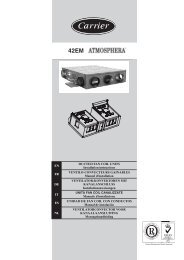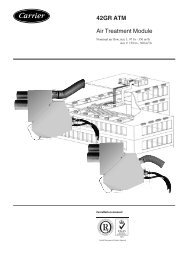19XR (PIC II) Hermetic Centrifugal Liquid Chillers 50 Hz - Carrier
19XR (PIC II) Hermetic Centrifugal Liquid Chillers 50 Hz - Carrier
19XR (PIC II) Hermetic Centrifugal Liquid Chillers 50 Hz - Carrier
Create successful ePaper yourself
Turn your PDF publications into a flip-book with our unique Google optimized e-Paper software.
8. Dissolved oxygen: Any sudden change in water oxygenation<br />
conditions must be avoided. It is as detrimental to<br />
deoxygenate the water by mixing it with inert gas as it is<br />
to over-oxygenate it by mixing it with pure oxygen. The<br />
disturbance of the oxygenation conditions encourages<br />
destabilisation of copper hydroxides and enlargement of<br />
particles.<br />
9. Specific resistance – electric conductivity: the higher the<br />
specific resistance, the slower the corrosion tendency.<br />
Values above 3000 Ohm/cm are desirable. A neutral<br />
environment favours maximum specific resistance values.<br />
For electric conductivity values in the order of 200-6000<br />
S/cm can be recommended.<br />
10. pH: Ideal case pH neutral at 20-25°C<br />
7 < pH < 8<br />
If the water circuit must be emptied for longer than one month,<br />
the complete circuit must be placed under nitrogen charge to<br />
avoid any risk of corrosion by differential aeration.<br />
Charging and removing heat exchange fluids should be done<br />
with devices that must be included on the water circuit by the<br />
installer. Never use the unit heat exchangers to add heat<br />
exchange fluid.<br />
Piping systems must be properly vented, with no stress on<br />
waterbox nozzles and covers. Use flexible connections to<br />
reduce the transmission of vibrations. Water flows through the<br />
cooler and condenser must meet job requirements. Measure the<br />
pressure drop across cooler and across condenser and compare<br />
this with the nominal values (see selection document).<br />
If the optional pumpout storage tank and/or pumpout system<br />
are installed, check to ensure the pumpout condenser water has<br />
been piped in. Check for field-supplied shutoff valves and<br />
controls as specified in the job data. Check for refrigerant leaks<br />
on field-installed piping. See Fig. 19 and 20.<br />
4.1.8 Check Relief Devices<br />
Be sure that relief devices have been piped to the outdoors in<br />
compliance with standard EN 378-2. Piping connections must<br />
allow for access to the valve mechanism for periodic inspection<br />
and leak testing. <strong>19XR</strong> relief valves are set to relieve at 1275 kPa<br />
chiller heat exchanger design pressure.<br />
4.2 - Chiller Tightness<br />
4.2.1 - Check chiller tightness<br />
Figure 25 outlines the proper sequence and procedures for leak<br />
testing.<br />
<strong>19XR</strong> chillers are shipped with the refrigerant contained in the<br />
condenser shell and the oil charge shipped in the compressor.<br />
The cooler will have a 225 kPa refrigerant charge. Units may<br />
be ordered with the refrigerant shipped separately, along with a<br />
225 kPa nitrogen-holding charge in each vessel. To determine if<br />
there are any leaks, the chiller should be charged with refrigerant.<br />
Use an electronic leak detector to check all flanges and solder<br />
joints after the chiller is pressurized. If any leaks are detected,<br />
follow the leak test procedure.<br />
40<br />
If the chiller is spring isolated, keep all springs blocked in both<br />
directions in order to prevent possible piping stress and damage<br />
during the transfer of refrigerant from vessel to vessel during the<br />
leak test process, or any time refrigerant is transferred. Adjust<br />
the springs when the refrigerant is in operating condition, and<br />
when the water circuits are full.<br />
4.2.2 - Refrigerant Tracer<br />
<strong>Carrier</strong> recommends the use of an environmentally acceptable<br />
refrigerant tracer for leak testing with an electronic detector.<br />
Ultrasonic leak detectors also can be used if the chiller is under<br />
pressure.<br />
WARNING: Do not use air or oxygen as a means of pressurizing<br />
the chiller. Mixtures of HFC-134a and air can undergo<br />
combustion.<br />
4.2.3 - Leak Test Chiller<br />
Due to regulations regarding refrigerant emissions and the difficulties<br />
associated with separating contaminants from refrigerant,<br />
<strong>Carrier</strong> recommends the following leak test procedures. See<br />
Fig. 25 for an outline of the leak test procedures.<br />
1. If the pressure readings are normal for chiller condition:<br />
a. Evacuate the holding charge from the vessels, if<br />
present.<br />
b. Raise the chiller pressure, if necessary, by adding<br />
refrigerant until pressure is at equivalent saturated<br />
pressure for the surrounding temperature. Follow the<br />
pumpout procedures in the Transfer Refrigerant from<br />
Pumpout Storage Tank to Chiller section, Steps 1a - e.<br />
WARNING: Never charge liquid refrigerant into the<br />
chiller if the pressure in the chiller is less than 241 kPa<br />
for HFC-134a. Charge as a gas only, with the cooler and<br />
condenser pumps running, until this pressure is reached,<br />
using PUMP-DOWN LOCKOUT and TERMINATE<br />
LOCKOUT mode on the <strong>PIC</strong> <strong>II</strong>. Flashing of liquid<br />
refrigerant at low pressures can cause tube freeze-up<br />
and considerable damage.<br />
c. Leak test chiller as outlined in Steps 3 -9.<br />
2. If the pressure readings are abnormal for chiller<br />
condition:<br />
a. Prepare to leak test chillers shipped with refrigerant<br />
(Step 2h).<br />
b. Check for large leaks by connecting a nitrogen bottle<br />
and raising the pressure to 207 kPa. Soap test all joints.<br />
If the test pressure holds for 30 minutes, prepare the<br />
test for small leaks (Steps 2g - h).<br />
c. Plainly mark any leaks which are found.<br />
d. Release the pressure in the system.<br />
e. Repair all leaks.<br />
f. Retest the joints that were repaired.<br />
g. After successfully completing the test for large leaks,<br />
remove as much nitrogen, air, and moisture as possible,<br />
given the fact that small leaks may be present in the<br />
system. This can be accomplished by following the<br />
dehydration procedure, outlined in the Chiller Dehydration<br />
section below.




